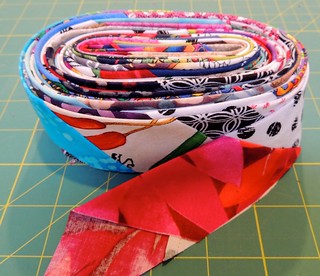 Ami asked for a tutorial of how I was making the string-pieced binding.
Ami asked for a tutorial of how I was making the string-pieced binding. Bonnie wondered why I was using such small pieces when–as I also mentioned in email to others yesterday–there are faster and more efficient ways to make it ... though, to be honest, this 9-plus yards of binding came together pretty quickly.
I decided to post about my process, answer the questions and ... have a reminder for myself, if I ever want to do this again.
My initial inclination would be to make wider string yardage, like this, and cut the binding strips (on a bias) from it, just like any other fabric. The diamonds that make up the string stars themselves were cut from fabric I made in the same batch as this, during a stash/scraps clean out.
Last year, I made more string fabric yardage (in a more narrow color palette, using width-of-fabric strips) for my Feather Bed quilt. (I know there's a photo on my blog of that fabric, but cannot find it). It really is the best (and fastest) way to go ...
But since I ONLY needed enough string fabric for a binding, I got the idea to pull strings from my bins of small scraps. Most of those are smaller than a 10 inch square. At first I thought I could make a "double wide" piece from which I could cut two binding widths, but ... I soon realized that when those strips are put on a 45 degree angle that an 8 inch strip, with triangles cut from each end to create the angle, resulted in something around 4 inches wide. My plan was for binding cut at 3 1/2 inches wide for a 1/2-inch wide double fold binding.
If you can make a wider piece of binding fabric using cut yardage or precut jelly rolls, I recommend you consider doing so.
Being fully committed to using my smaller scraps, here's what I did.
I cut a pile of strips approximately 8-inches long in varying widths. The wider the strip, the longer the strip will need to be–more on that later.
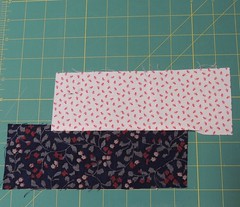 I didn't exactly put them in a paper bag (to randomly pull them out and add them), but my process was similar. I dumped them in a pile on my table next to the sewing machine and randomly grabbed and added, usually only choosing to which end of the pieced strings I'd add it.
I didn't exactly put them in a paper bag (to randomly pull them out and add them), but my process was similar. I dumped them in a pile on my table next to the sewing machine and randomly grabbed and added, usually only choosing to which end of the pieced strings I'd add it.To begin, align two strips along their long edges and offset on the left edge. Sew them together and press.
Now, using a ruler, cut this 2-unit piece into the shape and size.
Align the 45 degree angle line on the ruler with the bottom edge of the bottom strip and cut the angle on the left side.
Then cut the strip to slightly wider than the desired width. For my 3 1/2-inch wide binding strips, I cut mine at 4-inches.
Once you have established the angle, all you need to do is add a strip, sew it on, press and trim. When you add a strip, you align it on the left side, with the extra width on the right, like this.
As you continue to add the strings, you will see the how and why of "the wider the strip, the longer it needs to be." If a wide strip isn't long enough, you could end up with something like this, where, after it is trimmed, the point of the angle on the right side looks "chopped off." If this happens, just trim it parallel to the seam.
When you start, it seems like it could take ... forever. I started with 5 pieced binding strips, so that I could chain piece them--making it a little faster. I also thought that if I made them each approximately 2 yards long, which wouldn't become too unwieldy and could be be folded into quarters to trim to 3 1/2 inches before I joined them together.
When my chain-pieced strips became long enough, I would add a strip to one end, then pull the other end around and add a strip there as well. I am a few inches shy of 6 feet tall (2 yards), which made eyeballing my progress easy: waist-high, shoulder-high, eye-level, over-my-head, done.
When I got close, I actually stopped to measure the quilt and figure out exactly how much binding I needed–328 inches, which is a little more than 9 yards, so I stopped before I reached my 5 strips over-my-head or 10 yards goal. And a funny thing happened when I sewed it to the quilt–a binding miracle: it was EXACTLY the right size.
I started hand stitching down the binding last night while I watched television. I truly AM a SLOW stitcher and have a ways to go. It's now rolled up in the basket in the den waiting for me to return.
I probably used more clips to hold the binding in place than usual because of all the seams in the string-piecing. Every seam in the binding has a clip to keep it under control.
Since I cannot (yet) show you what's on my Design Wall (a super secret Cotton Robin project that won't be revealed until summer), I am sharing my process from work table and basket.




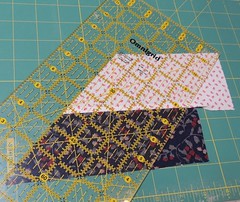

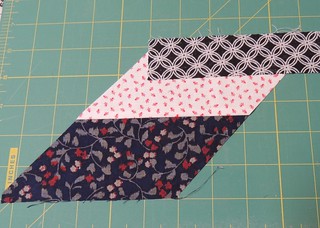

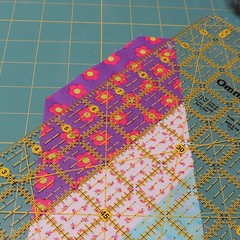
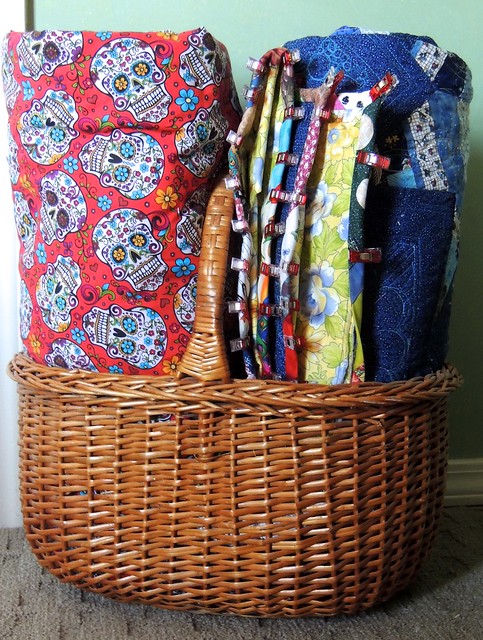
4 comments:
I am definitely going to have to try your binding method on something soon! Thanks for all the explanation and photos!
I save my leftover bindings from all my quilts and sew them together too for my scrappy quilts. Of course, they are already 2.5" so there is no measuring or trimming needed. Thanks for your tutorial on how you do it.
amazing!!!
who knew???
i was always taught to make sure the bind has as few seams as possible - because you wouldn't want a seam to be positioned on the corners...
your way throws that whole thought out the window...... and i am so-o-o glad.
thanks
xo
eva
I love it when there's an exactly-right-size miracle. =)
Post a Comment